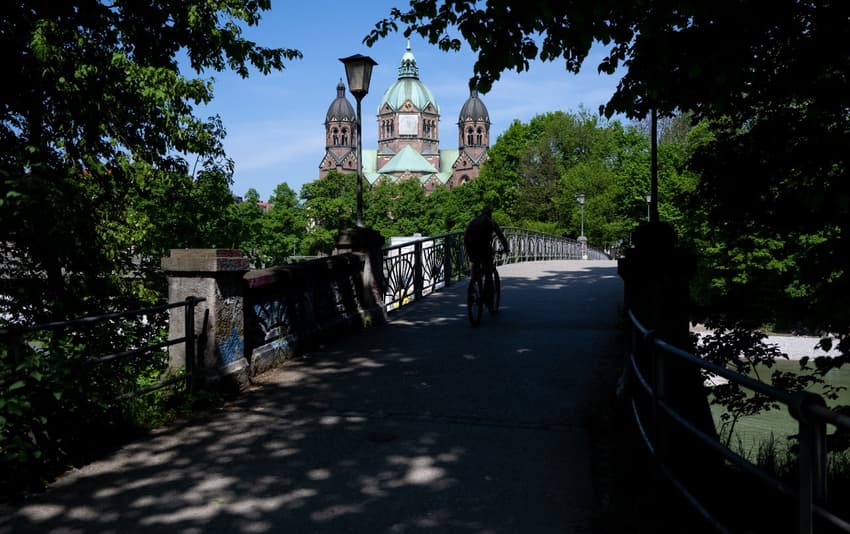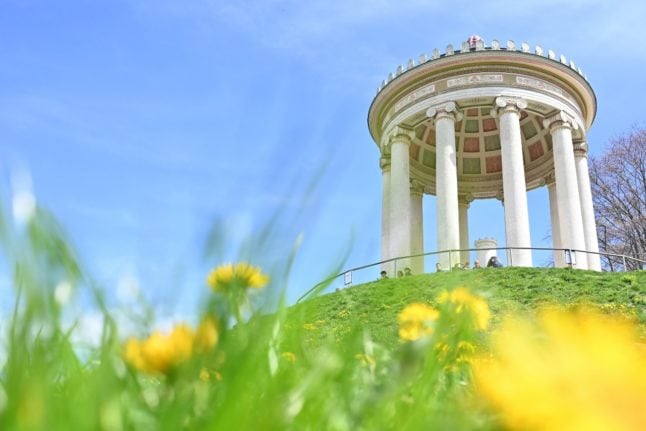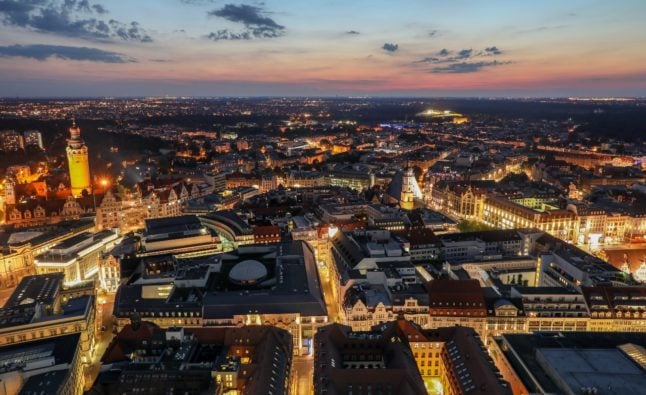Which areas in Munich are most popular with foreigners?

Munich isn't only one of Germany's most picturesque cities - it's a magnet for foreigners looking to start a new life. Here's a guide to some of the areas the international community loves the most.
In the long list of German cities, Munich has long been a favourite destination for foreigners.
The Bavarian capital is known for its sprawling parks and beer gardens, pristine Altstadt and access to the great outdoors, not to mention its charming cafes and high-end shopping districts. So it's no wonder that more than a quarter (26 percent) of the some 1.4 million people living in Munich have moved there from abroad.
If you're looking to start a life in Munich - either with a family, as an international student or in a new career - you may be wondering where you can best tap into this multicultural community.
To help you get started, here are some of the areas that are most popular with foreigners, from hip suburbs to sleepy residential districts.
Maxvorstadt
If access to world-class universities, galleries and cultural facilities is your priority, look no further than Maxvorstadt - the buzzing intellectual heart of Munich.
Located just outside the Altstadt in the northwest of the city, residents here are just a stone's throw from the idyllic Englischer Garten, so you'll have plenty of green space for jogging, cycling and picnics with friends.
Better still, many of Munich's top attractions are located in Maxvorstadt itself. This is the district where all three of the major universities - Ludwig Maximilians University, Kunstakademie and the Technical University - are based.
READ ALSO: 'World's largest village': How foreigners in Germany feel about Munich

Munich's Englischer Garten in the sun. Photo: picture alliance/dpa | Jacqueline Melcher
Art fans will be spoilt for choice in the arts district known as Kunstreal, where you can visit all three of the major galleries (or Pinakotheken), from the modern to the old. And while it may not quite have the thriving nightlife you find in other parts of the city, it is home to some of Munich's prettiest beer gardens and historic breweries such as the Löwenbraukeller and Augustinerkeller.
Finding a place to live in Maxvorstadt does come with a steep price tag, so if you're on a tight budget, it may not be the place for you. That said, it does have one of the highest concentrations of foreigners in Munich, so internationals are bound to feel right at home.
Schwabing
Up to the north of the city, running along the west of the Englisher Garten and up to the Olympiapark, is Munich's bustling bohemian district of Schwabing.
Due to its proximity to the universities, this area has long been a popular choice for students and academics, not to mention artists and other creatives who are captivated by its array of independent galleries, trendy cafes and boutique shops.
It's also known for its charming historic buildings and airy Altbau apartments, so if you dream of living somewhere pristine and picturesque, Schwabing could be the perfect choice. However, it's worth mentioning that the area's popularity and high-end apartments have led prices to spike in recent years.
With so many creative types, international students and young professionals drawn to the area, however, it's the perfect place to meet fascinating people from all over the world.
Ludwigsvorstadt & Isarvorstadt
Centrally located just south of Munich's charming Altstadt, Ludwigvorstadt-Isarvorstadt is the place to be if you want to be immersed in the action.
On a night out, this is one of the top places to go to find world-class restaurants and bustling bars, not to mention Glochenbachviertal, where the majority of Munich's vibrant gay bars and clubs are located.

Munich city centre at night. Photo: picture alliance / Jan Woitas/dpa-Zentralbild/dpa | Jan Woitas
With new office buildings and hip co-working spaces springing up all the time, it's a great area for young expats who want to live close to work but also in one of the most lively parts of the city. And with the Isar river running along the eastern border of the district, you'll have a perfect route for your morning or evening run or cycle.
One other major benefit of living in Ludwigsvorstadt is that the area is also home to Munich Hauptbahnhof, so it's the perfect launchpad for jetting off around Germany or even Austria or Italy. What's more, the district is known for its multiculturality, and has even been nicknamed 'Little Istanbul' due to its prominent Turkish community.
READ ALSO: REVEALED: 10 of the best hiking day trips from Munich
Berg-am-Laim
With rental prices shooting up in Munich over the past decades, suburbs like Berg-am-Laim are becoming the go-to choice for internationals who don't have a banker's salary.
This relaxed neighbourhood is a working class area with affordable housing and plenty of green spaces, making it a great choice for someone looking for a more laid-back option that's still only 15-20 minutes by train from the centre.
Less than a decade ago, Berg-am-Laim was home to some of Munich's most off-beat clubs and nightlife, but in recent years, these have closed down to make way for more residential housing.
With its array of international schools, it's also ideal for families who want their children to learn in a more multicultural environment. It also happens to be the number one choice for many internationals moving to Munich these days, so anyone craving a strong sense of community is bound to feel right at home there.
Giesing
A little more removed from the centre in the southern part of Munich is the quiet, family-friendly district of Giesing.
Here, you can find much more affordable housing than in the hip central districts, but also a sense of local community and enough shops, bars and cafes to keep you entertained.
READ ALSO: It's not impossible: How to find housing in Munich
With plenty of local schools, parks and playgrounds on offer, Giesing has become something of an enclave for young families and particularly internationals in recent years, so it's a great place to make friends and build a sense of community.
Despite its quiet, residential feel, you're also no more than a 20 minute bike ride or 15 minute train journey away from most of the action as well, so you won't be entirely cut off from the world-class cultural attractions and colourful nightlife that Munich has to offer.
Comments
See Also
In the long list of German cities, Munich has long been a favourite destination for foreigners.
The Bavarian capital is known for its sprawling parks and beer gardens, pristine Altstadt and access to the great outdoors, not to mention its charming cafes and high-end shopping districts. So it's no wonder that more than a quarter (26 percent) of the some 1.4 million people living in Munich have moved there from abroad.
If you're looking to start a life in Munich - either with a family, as an international student or in a new career - you may be wondering where you can best tap into this multicultural community.
To help you get started, here are some of the areas that are most popular with foreigners, from hip suburbs to sleepy residential districts.
Maxvorstadt
If access to world-class universities, galleries and cultural facilities is your priority, look no further than Maxvorstadt - the buzzing intellectual heart of Munich.
Located just outside the Altstadt in the northwest of the city, residents here are just a stone's throw from the idyllic Englischer Garten, so you'll have plenty of green space for jogging, cycling and picnics with friends.
Better still, many of Munich's top attractions are located in Maxvorstadt itself. This is the district where all three of the major universities - Ludwig Maximilians University, Kunstakademie and the Technical University - are based.
READ ALSO: 'World's largest village': How foreigners in Germany feel about Munich

Art fans will be spoilt for choice in the arts district known as Kunstreal, where you can visit all three of the major galleries (or Pinakotheken), from the modern to the old. And while it may not quite have the thriving nightlife you find in other parts of the city, it is home to some of Munich's prettiest beer gardens and historic breweries such as the Löwenbraukeller and Augustinerkeller.
Finding a place to live in Maxvorstadt does come with a steep price tag, so if you're on a tight budget, it may not be the place for you. That said, it does have one of the highest concentrations of foreigners in Munich, so internationals are bound to feel right at home.
Schwabing
Up to the north of the city, running along the west of the Englisher Garten and up to the Olympiapark, is Munich's bustling bohemian district of Schwabing.
Due to its proximity to the universities, this area has long been a popular choice for students and academics, not to mention artists and other creatives who are captivated by its array of independent galleries, trendy cafes and boutique shops.
It's also known for its charming historic buildings and airy Altbau apartments, so if you dream of living somewhere pristine and picturesque, Schwabing could be the perfect choice. However, it's worth mentioning that the area's popularity and high-end apartments have led prices to spike in recent years.
With so many creative types, international students and young professionals drawn to the area, however, it's the perfect place to meet fascinating people from all over the world.
Ludwigsvorstadt & Isarvorstadt
Centrally located just south of Munich's charming Altstadt, Ludwigvorstadt-Isarvorstadt is the place to be if you want to be immersed in the action.
On a night out, this is one of the top places to go to find world-class restaurants and bustling bars, not to mention Glochenbachviertal, where the majority of Munich's vibrant gay bars and clubs are located.

With new office buildings and hip co-working spaces springing up all the time, it's a great area for young expats who want to live close to work but also in one of the most lively parts of the city. And with the Isar river running along the eastern border of the district, you'll have a perfect route for your morning or evening run or cycle.
One other major benefit of living in Ludwigsvorstadt is that the area is also home to Munich Hauptbahnhof, so it's the perfect launchpad for jetting off around Germany or even Austria or Italy. What's more, the district is known for its multiculturality, and has even been nicknamed 'Little Istanbul' due to its prominent Turkish community.
READ ALSO: REVEALED: 10 of the best hiking day trips from Munich
Berg-am-Laim
With rental prices shooting up in Munich over the past decades, suburbs like Berg-am-Laim are becoming the go-to choice for internationals who don't have a banker's salary.
This relaxed neighbourhood is a working class area with affordable housing and plenty of green spaces, making it a great choice for someone looking for a more laid-back option that's still only 15-20 minutes by train from the centre.
Less than a decade ago, Berg-am-Laim was home to some of Munich's most off-beat clubs and nightlife, but in recent years, these have closed down to make way for more residential housing.
With its array of international schools, it's also ideal for families who want their children to learn in a more multicultural environment. It also happens to be the number one choice for many internationals moving to Munich these days, so anyone craving a strong sense of community is bound to feel right at home there.
Giesing
A little more removed from the centre in the southern part of Munich is the quiet, family-friendly district of Giesing.
Here, you can find much more affordable housing than in the hip central districts, but also a sense of local community and enough shops, bars and cafes to keep you entertained.
READ ALSO: It's not impossible: How to find housing in Munich
With plenty of local schools, parks and playgrounds on offer, Giesing has become something of an enclave for young families and particularly internationals in recent years, so it's a great place to make friends and build a sense of community.
Despite its quiet, residential feel, you're also no more than a 20 minute bike ride or 15 minute train journey away from most of the action as well, so you won't be entirely cut off from the world-class cultural attractions and colourful nightlife that Munich has to offer.
Join the conversation in our comments section below. Share your own views and experience and if you have a question or suggestion for our journalists then email us at [email protected].
Please keep comments civil, constructive and on topic – and make sure to read our terms of use before getting involved.
Please log in here to leave a comment.